Photographs: Utpal Baruah/Reuters Ajai Shukla
My first glimpse of Shangri-La blows away the fatigue. After eight gruelling hours of bumping along the mountain road from Along (itself a full day's drive from the Assam plains), the Bolero rounds a corner and the thickly-forested gorge opens into a wide valley.
Here is Menchuka, the remote, mystical valley through which meanders the medicinal Yar Gyap Chu River. (In Tibetan, men is "medicinal", chu is "water", and ka is "alongside".)
It is a crystal-clear day, rare on the rainy, 17,000 ft-high Himalayan watershed which is the McMahon Line, the disputed border between India and Tibet in Arunachal Pradesh. Steep mountain walls enclose the valley on either side with snow-clad ramparts.
Such is the geography of Arunachal Pradesh, our north-eastern version of the Land of the Five Rivers.
...
Amazing photos of a 'hidden paradise'
Image: An elderly lady of the Manpa tribe spins prayer wheels at a monastery in Tawang in Arunachal Pradesh near the border with China.Photographs: Utpal Baruah/Reuters
Five major rivers flow from the eastern Himalayas to the Brahmaputra in Assam, their valleys separated by 16,000 ft-high ridges.
These are not rivulets but mighty torrents - the Lohit, Dibang, Siang, Subansiri and Kameng - which meet to form the Brahmaputra, the soul of Assam. A mere handful of roads connects these river valleys to one another.
For the most part, the only way to travel from one valley to the next is to drive down the valley for a day or more to Assam, then drive along the Brahmaputra on National Highway 52, and then do the long drive upriver to one's destination in the other valley.
...
Amazing photos of a 'hidden paradise'
Image: Tribesmen from the Idu-Mishmi community perform a tribal dance during the Statehood Festival in Motum village in Arunachal Pradesh.Photographs: Caroline Singh/Reuters
This downriver-upriver layout sometimes requires a three-day road journey to a destination that is just 70 km away on the map. Near the river, at the entrance to Menchuka, a town of 10,000 people, is a spot marked by a sea of Buddhist prayer flags.
This commemorates what used to be the rock seal of Guru Rimpoche, which marked Menchuka as one of the "hidden valleys" of Tibetan lore.
According to legend, the 8th-century Guru Padmasambhava - since he carried Buddhism from India to Tibet and founded the Nyingma sect, Tibetans regard Guru Rimpoche as second only to the Buddha himself - guarded against the inevitable moral degeneration of his followers by secreting a number of hidden sanctuaries, each a remote, beautiful, unpopulated paradise, to which the faithful could migrate when life became unbearable.
...
Amazing photos of a 'hidden paradise'
Image: A woman dries corn in her compound in Bomdila in Arunachal Pradesh.Photographs: Stringer/Reuters
Guru Rimpoche hid the keys to these sanctuaries. It required an exceptional person, known as a terton, endowed with high moral qualities, to decode the location of a hidden valley through a set of clues called a terma.
In Guru Rimpoche's great plan, the terton would then guide his followers to one of these Shangri-Las which would be marked by a sign, such as a rock shaped in a certain way or stamped with a seal. Legend has it that Sikkim was the first of these hidden treasures to which paradise-seekers migrated in the 14th century.
That initial foothold was followed by full-scale Tibetan colonisation in the 17th century and the establishment of a dynasty by the Choegyals, who ruled Sikkim until India annexed it in 1974.
...
Amazing photos of a 'hidden paradise'
Image: A Monpa tribal girl wearing traditional dress poses with a photograph of a Buddhist priest as her brother looks on in Tawang in Arunachal Pradesh.Photographs: Utpal Baruah/Reuters
In the early 18th century, a terton from Kongpo, the rugged yet beautiful area around the Tsangpo bend in Tibet, led his paradise-seeking followers away from the depredations of the invading Mongols into what is today Menchuka.
Paradise, however, was short-lived. By the 19th century, Menchuka became a lucrative addition to the Gachak estate in Kongpo and its wealth of agricultural produce, livestock and medicinal plants was heavily taxed.
Even after India's independence, the local Buddhist Memba people continued to pay tribute to the masters in Tibet. That relationship ended with the arrival of India, when a platoon of 2nd Assam Rifles marched into Menchuka in 1948.
The Indians brought in strange ideas, recounts 70-year-old Pema Phelye, including the abolition of slavery, a tradition by which Tagin tribesmen from Subansiri were purchased by Membas for domestic and agricultural work.
...
Amazing photos of a 'hidden paradise'
Image: An aerial view shows the Tawang monastery in Arunachal Pradesh near the border with China.Photographs: Utpal Baruah/Reuters
A cadre of competent and sensitive administrators from the pioneering Indian Frontier Administrative Service ended slavery and the rule of the local Tibetan chieftains, one of whom was Deb Pema.
But what made India unquestionably welcome in Menchuka was an end to the punishing tax payments to the overlords in Kongpo. Menchuka today, like Tawang, and the neighbouring valley of Manigong, remains a Buddhist enclave in an area that was historically home to the tribal Lhobas, or "savages", as the Tibetans saw them.
The people of the Brahmaputra valley saw these remote hill tribes the same way; the Assamese called them Abors or "uncontrolled". These masters of the forest are today the Adi tribe, as cultured and sophisticated as any people in the country, who have long played a dominant role in the politics of Arunachal Pradesh.
...
Amazing photos of a 'hidden paradise'
Image: A girl from the Manpa tribe dries maize at Chander village in Arunachal Pradesh.Photographs: Stringer/Reuters
The old links with Tibet made Menchuka a key Chinese objective in the 1962 war, along with Tawang and Walong. A handful of Indian defenders from the 2 Madras and 2/8 Gorkha Rifles were ordered to withdraw in the face of a Chinese advance and join a larger force at Taliha in the neighbouring Subansiri valley.
Harried by fast-moving patrols from the People's Liberation Army, most of them perished in the retreat. An entire Gurkha platoon (36 soldiers), led by four officers, disappeared without trace in the thickly forested mountains while attempting a suicidal cross-country move to Taliha.
Locals still recount tales about the month that they spent under PLA occupation, after Beijing's unilateral ceasefire of November 21, 1962.
...
Amazing photos of a 'hidden paradise'
Image: Dancers from Arunachal Pradesh wait to perform at a cultural show in Agartala, capital of Tripura.Photographs: Jayanta Dey/Reuters
Chinese soldiers did everything they could to win local loyalty, but the Membas, with memories of the Tibet revolt of 1959 fresh in their minds, saw through the opportunism in their overtures.
Today, the Chinese would face an immeasurably more difficult task if they attacked Menchuka. It is strongly defended by the army's Red Devils.
The army presence can hardly be missed, whether in the form of heavy vehicles growling along the roads, a very visible army encampment, military signposts everywhere (sample: "After a hard day's work and sweat we, the Red Devils, love to have Chinese for supper"), or the AN-32 transport aircraft that roar in and out of the airfield in the middle of Menchuka town, bringing in the supplies that keep the army going.
...
Amazing photos of a 'hidden paradise'
Image: Workers warm themselves around a fire on a cold foggy day at a stone crusher plant in Tawang in Arunachal Pradesh.Photographs: Adnan Abidi/Reuters
On their way back to Assam, the AN-32s give lifts to locals who need to move out in a hurry. The actual border with China is at the Lola Pass, some 45km from Menchuka. The Line of Actual Control (as the border is called) is not disputed here, as it is in other sectors like Longju.
But Tibetan civilians have been apprehended in Indian territory while gathering the medicinal plants that this valley has always been famous for. Locals tell us that the Indo-Tibetan Border Police, which physically guards the border, arrested a large group of Tibetans some six years ago when they intruded into India.
...
Amazing photos of a 'hidden paradise'
Image: Children of labourers play cricket on a street near a stone crusher plant in Tawang in Arunachal Pradesh.Photographs: Adnan Abidi/Reuters
Intrigued, I go to the sub-division headquarters, where I meet Additional Deputy Commissioner Gepak Poyum, an Adi from Along. A small-framed man in a tiny office, with a photograph of Subhas Chandra Bose hanging on the wall, Poyum is kept warm by a wood-burning bukhari that crackles comfortingly.
With not a file on his desk, he is happy to chat with a visitor from Delhi. Yes, the Tibetans did come, and were kept by ITBP for about a month, he tells us. They must have been collecting yartsa gunbu, the magical plant that grows in high mountain pastures, transforming into a caterpillar in winter and a fungus in summer.
China loves yartsa gunbu, I learn; it is reputedly a potent aphrodisiac. It is sent to Tibet for the equivalent of Rs 80,000 per kg; the street value in Menchuka of 1 kg of yartsa gunbu is Rs 30,000.
...
Amazing photos of a 'hidden paradise'
Image: A view of the last Chinese army post is seen from the Indian side at the Indo-China border in Bumla in Arunachal Pradesh.Photographs: Adnan Abidi/Reuters
What happened to the Tibetans, I ask? Poyum tells me that release orders came from New Delhi because they had strayed across by accident. In early 2007, they were repatriated across Lola. Clearly things on the ground between India and China are not as bad as many imagine.
Menchuka's long tradition of medicinal herbs, which formed a sizeable component of the tax payments to Kongpo, is now being commercialised. Pasang Sona, the MLA from Menchuka, has leased a large tract of land to Pronaali Agro-Tech, a company run by former tea planter Giri Sodhi.
Perched on a hillside with a spectacular view of Menchuka, Sodhi has converted this into a plantation for Taxus bacata, an evergreen conifer long known as the yew.
...
Amazing photos of a 'hidden paradise'
Image: A dog rests on the Indian side of the Indo-China border at Bumla in Arunachal Pradesh.Photographs: Adnan Abidi/Reuters
The toxic component of Taxus Bacata, known as taxol, is a powerful chemotherapeutic drug for treating breast and cervical cancer. Sodhi has tied up with German pharmaceutical company Fresenius Kabi Oncology (it acquired Dabur Pharma some years ago) which will process Menchuka's Taxus bacata in its laboratories in Sahibabad and Kalyani into anti-cancer medicines.
Fresenius Kabi currently imports Taxus bacata from Europe and South America; it hopes to cut costs to one third by sourcing it from Menchuka. For Sodhi, this is a high-stakes, high-risk game, with a strong element of adventure.
...
Amazing photos of a 'hidden paradise'
Image: A signboard is seen from the Indian side of the Indo-China border at Bumla in Arunachal Pradesh.Photographs: Adnan Abidi/Reuters
He says: "My expenditure on 70 hectares of Taxus bacata, over 20 years, on field development, planting, irrigation and labour will work out to about Rs 25 crore. And my income flow will only begin after six or seven years. But Fresenius-Kabi is supporting this strongly."
He adds: "This is hard work, 20 hours' driving time from Assam in a very remote area. But it is very enjoyable, and I take satisfaction in being able to cut treatment costs for cancer patients in the future."
The Arunachal Government is watching and waiting. Poyum says: "We are watching to see how this works. If it is a success, other locals will also start growing. And definitely, we will support [it] because the tradition in Menchuka of growing medicinal herbs stopped due to medicines coming from Kolkata and Mumbai."
...
Amazing photos of a 'hidden paradise'
Image: People perform a Monastic dance, a dance performed mainly by monks at a monastery, at the inauguration of a three-day Buddha festival in Tawang district in Arunachal Pradesh.Photographs: Stringer/Reuters
We look out at Menchuka from Sodhi's fields, where lovely Memba women tend to the plants. The Yar Gyap Chu flows placidly, an island in midstream shaped exactly like India. An army patrol climbs the hill slowly, familiarising itself with the area they are tasked to defend.
A few years ago, when the road to Menchuka was being completed, the Border Roads Organisation was blasting Guru Rimpoche's rock seal which was in the way. But nobody from Menchuka protested. In traditional Tibetan Buddhist belief, paradise had already been desecrated when armed forces entered it and a war was fought there in 1962. Menchuka has moved on from its legendary past.

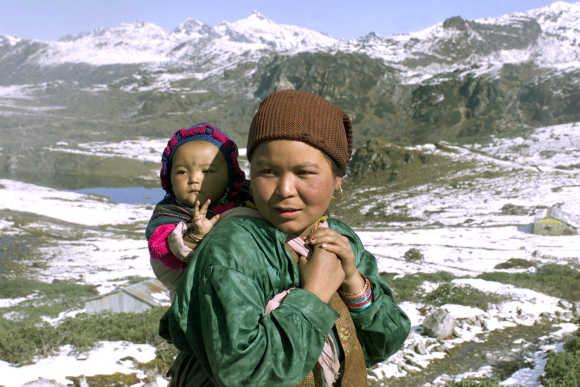
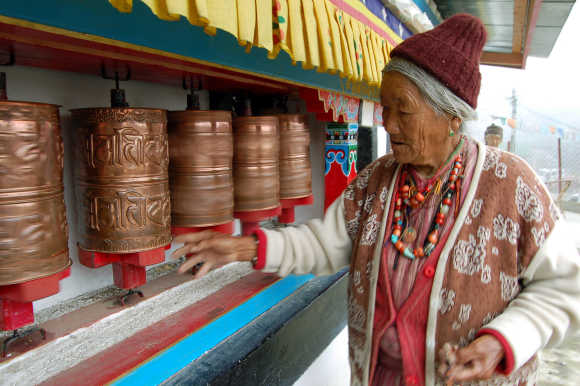
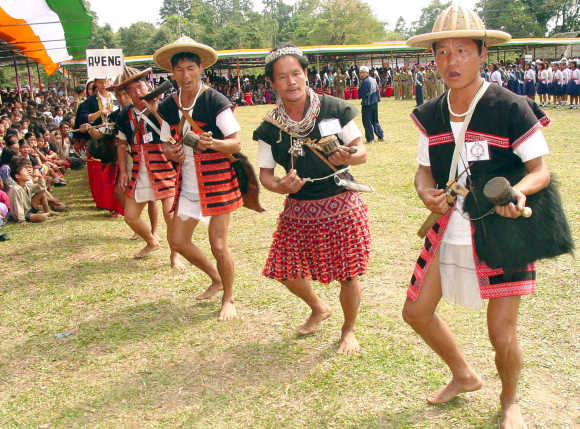
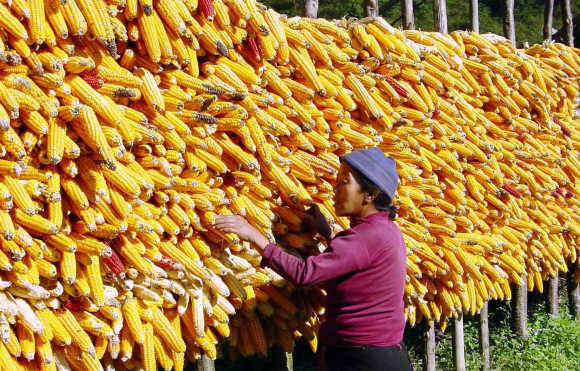
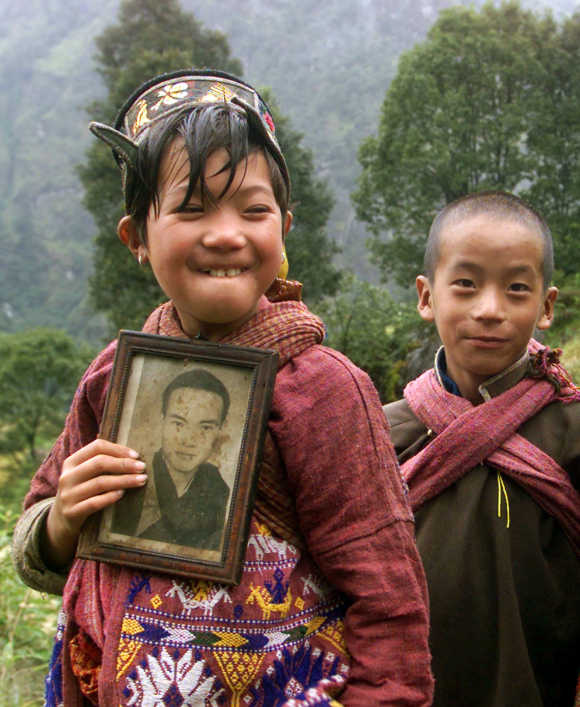
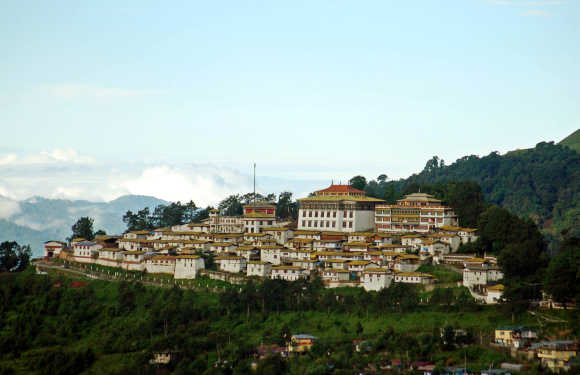
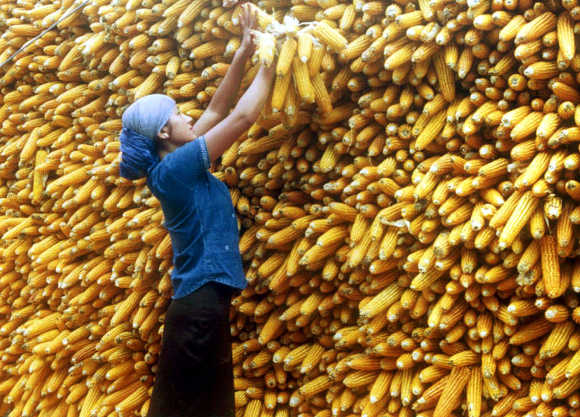
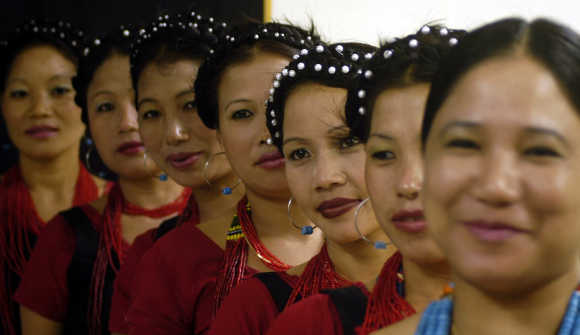
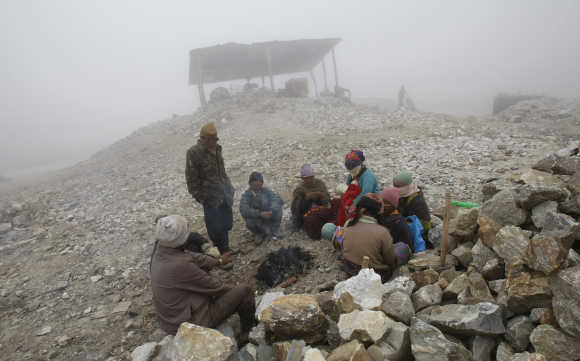

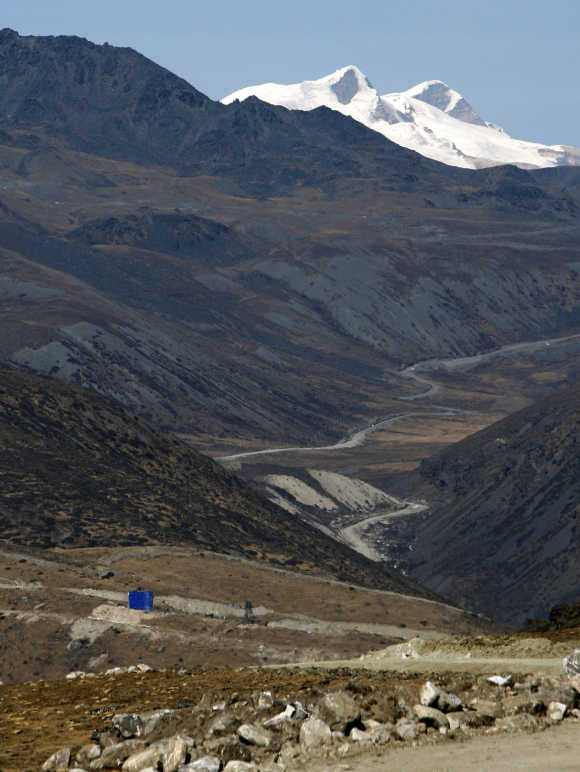
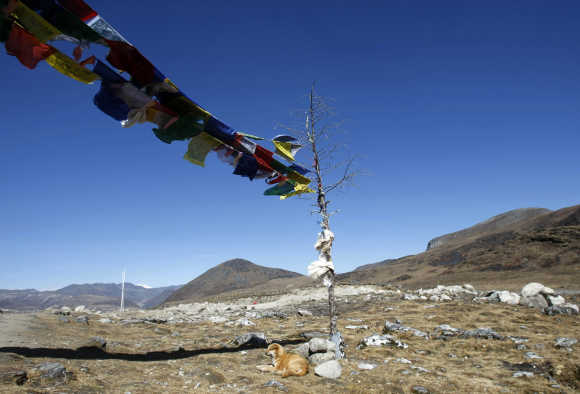

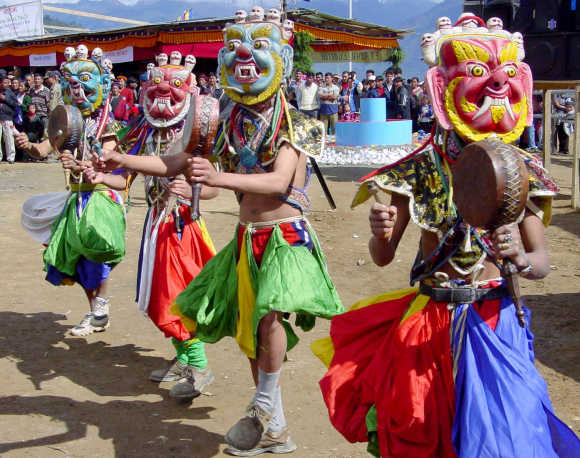

article